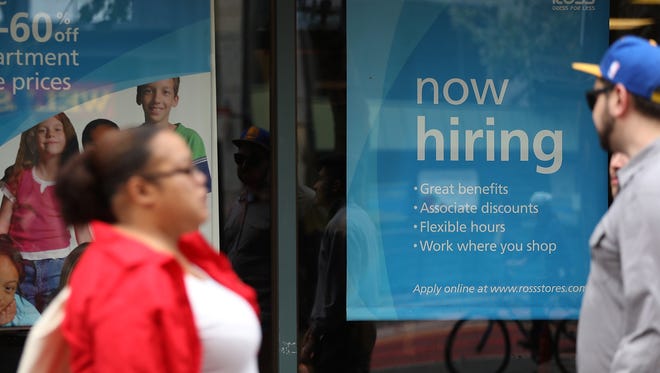Slowing job growth in Aug. lowers odds of Sept. rate hike

U.S. payroll growth slowed in August after two booming months as employers added 151,000 jobs, underscoring that employment growth may be moderating and lowering the odds of a Federal Reserve interest rate hike this month.
The unemployment rate was unchanged at 4.9%, the Labor Department said Friday.
Economists had forecast 180,000 job gains, according to a Bloomberg survey.
The report is the most significant the Fed will review before deciding whether to raise interest rates at a meeting Sept. 20-21. Some economists said gains of at least 200,000 would make a rate hike likely while others said blockbuster advances of more than 250,000 were needed to convince wary Fed policymakers.
The Dow Jones industrial average rose more than 70 points Friday as the tempered job gains eased traders' concerns that the Fed was poised to lift interest rates this month.
Stock averages up 0.4% despite weak jobs data
“The data-dependent Fed will most likely see the payroll numbers as taking pressure off any immediate need to hike interest rates," Chris Williamson, chief business economist at IHS Markit, wrote in a note to clients.
Some Fed officials remain concerned about lifting rates amid excessively low inflation and economic growth averaging just 1% at an annual rate the past three quarters. Sluggish exports and business investment spurred by a weak global economy and low oil prices have offset strong consumer spending. The worries have prompted the Fed to hold its key rate steady after raising it in December for the first time in nine years.
Also muddying the picture: The Labor Department has underestimated August employment gains the past five years by an average 62,000, based on subsequent revisions, according to an analysis by High Frequency Economics. In an interview, Labor Secretary Thomas Perez cited some schools' late reports of returning teachers and other staffers as one possible cause. That could ease any concerns caused by a weak August tally, though economists said a poor showing still would probably prompt the Fed to hold off on a rate hike.

Despite the disappointing tally, Perez said, "This is a solid report," noting it's nearly double the job gains needed to keep the unemployment rate from rising.
Monthly job growth has averaged 181,000 this year, below averages of 229,000 last year and 251,000 in 2014. Like many economists, Perez cited a natural downshift as the low unemployment rate provides employers with a smaller pool of available workers. He said Congress can do more to spur stronger job growth, such as boosting spending on infrastructure upgrades, passing immigration changes and raising the federal minimum wage. "We need to do more to stimulate demand," he said.
Last month, businesses added 126,000 jobs, led by health care, leisure and hospitality, and professional and business services. Federal, state and local governments added 25,000.
Job gains for June and July were revised down by a trivial 1,000 and those months still produced a blockbuster average of 273,000.
Average hourly earnings rose 4 cents to $25.73 and are up 2.4% the past year, down from 2.6% in July. Wage growth has picked up this year from the roughly 2% pace of the recovery but has yet to bust out despite the low unemployment rate. The Fed would like to see sharper pay gains before raising interest rates again.
Wages generally are likely to climb. Robert Half Staffing predicted this week that salaries for white-collar workers such as accountants, Web developers, paralegals and executive assistants will rise 3.6% in 2017.
Other mild negatives in the jobs report included a drop in the average workweek to 34.3 hours from 34.4 hours and a 3,100 decline in temporary workers. Employers who reduce the hours of workers and cut back on temps may not be inclined to step up hiring substantially in future months.
Job gains were subdued across the board in August. The health care sector added 36,000 jobs; leisure and hospitality added 29,000; professional and business services 22,000; and retailers 15,000.
Manufacturers coping with a weak global economy and the oil slump cut 14,000 jobs. Construction firms, which struggle to find skilled workers, trimmed 6,000.
Some other labor market barometers have sagged recently. Payroll processor ADP estimated that businesses added 177,000 jobs in August. And a survey of manufacturing activity showed falling employment.
Jobless claims, a measure of layoffs, remain near all-time lows.